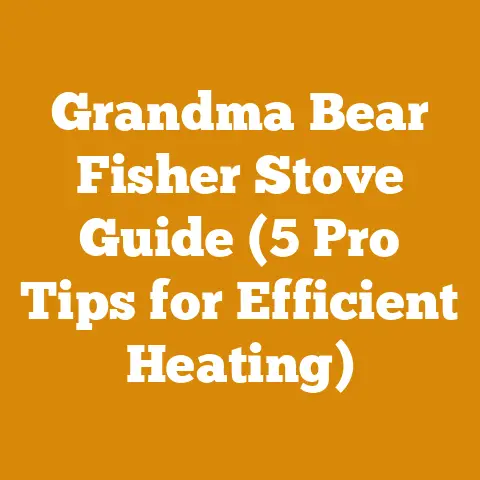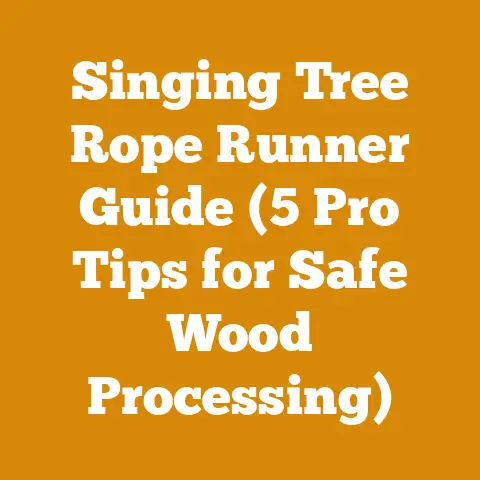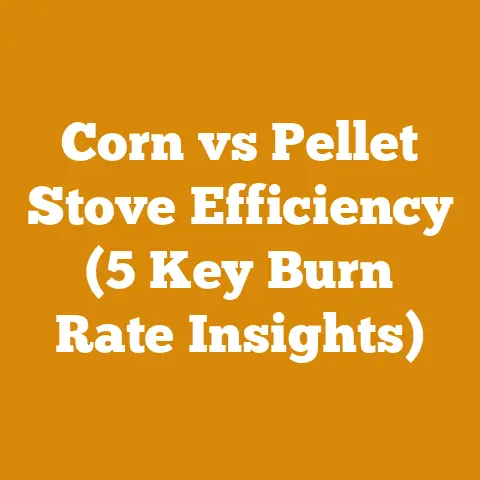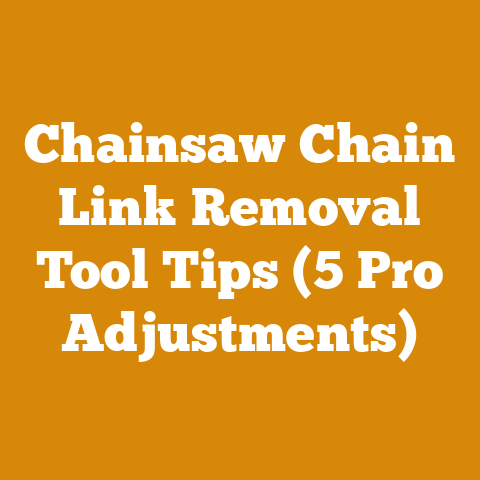Pellet Stove Making Loud Humming Noise (5 Expert Fixes)
Let’s tackle that annoying humming from your pellet stove head-on! Often, a loud humming noise indicates a problem with airflow, motor function, or even just plain old maintenance. In this guide, I’ll walk you through five expert fixes I’ve learned over years of working with pellet stoves, from simple cleaning to more involved component checks. You’ll learn how to diagnose the source of the hum and implement practical solutions to get your stove running quietly and efficiently again.
Pellet Stove Making Loud Humming Noise: 5 Expert Fixes
A humming pellet stove isn’t just an annoyance; it can signal underlying issues that affect performance and longevity. Ignoring it could lead to bigger problems down the line. I’ve seen everything from simple clogs to failing motors cause these noises, so let’s get to the bottom of it.
1. The Importance of Regular Cleaning and Maintenance
My first piece of advice, and often the solution, is to prioritize regular cleaning. Dust, ash, and unburnt pellets can accumulate inside the stove, obstructing airflow and causing motors to work harder, resulting in that dreaded hum.
Why Cleaning Matters:
- Improved Airflow: A clean stove allows for efficient combustion, reducing stress on the blower motor.
- Reduced Motor Strain: Removing obstructions means motors don’t have to work as hard, minimizing noise and extending their lifespan.
- Better Heating Efficiency: A clean stove burns pellets more completely, providing more heat output for your fuel.
My Experience: I remember one winter when my own pellet stove started humming loudly. I was convinced it was a major component failure. Turns out, the exhaust vent was almost completely blocked with ash! A thorough cleaning solved the problem instantly.
Actionable Steps:
- Daily Ash Removal: Empty the ash pan daily or every other day, depending on usage.
- Weekly Cleaning: Use a specialized pellet stove brush and vacuum to clean the burn pot, heat exchanger tubes, and exhaust pathways.
- Monthly Deep Clean: Disconnect the stove from power and thoroughly clean all accessible components, including the combustion blower and convection blower. Refer to your owner’s manual for specific instructions.
- Annual Professional Inspection: Schedule a professional inspection and cleaning at least once a year, especially before the heating season.
- Check the Exhaust Vent: Inspect the exhaust vent regularly for obstructions. Clear any blockages, such as bird nests or accumulated ash, immediately. I use a flexible chimney brush for this, ensuring I get the entire length of the vent.
Data and Insights: According to the Pellet Fuels Institute, regular maintenance can improve a pellet stove’s efficiency by up to 20%. That’s a significant saving on fuel costs and a quieter stove!
Tool List:
- Pellet Stove Brush
- Pellet Stove Vacuum with HEPA filter
- Screwdrivers (various sizes)
- Wrenches (various sizes)
- Chimney Brush (for exhaust vent cleaning)
- Gloves
- Safety Glasses
Measurement: Check the ash buildup in the burn pot weekly. If it’s more than an inch thick, it’s time for a more thorough cleaning.
Takeaway: Start with a deep clean! You’d be surprised how often this simple step resolves humming issues. Next, let’s dive into the combustion blower.
2. Inspecting and Cleaning the Combustion Blower
The combustion blower is responsible for providing air to the burn pot, which is crucial for efficient pellet combustion. If it’s dirty or malfunctioning, it can cause a loud humming noise.
Understanding the Combustion Blower:
- Function: The combustion blower forces air into the burn pot, ensuring proper combustion of the pellets.
- Common Issues: Dust buildup, worn bearings, and loose mounting screws can all cause the blower to hum loudly.
- Safety First: Always disconnect the stove from power before inspecting or cleaning the blower.
My Experience: I once worked on a stove where the combustion blower was caked in dust and debris. The homeowner had never cleaned it, and the blower was struggling to operate. After a careful cleaning, the stove ran like new, and the humming disappeared.
Actionable Steps:
- Locate the Blower: Refer to your owner’s manual to find the combustion blower’s location. It’s typically located near the burn pot.
- Disconnect Power: Unplug the stove from the electrical outlet.
- Remove the Blower: Carefully remove the blower assembly. You may need to remove screws or clips.
- Clean the Blower: Use a soft brush and vacuum to remove dust and debris from the blower blades and housing. Pay close attention to the motor housing.
- Inspect the Blades: Check the blower blades for damage or warping. Replace the blower if the blades are damaged.
- Lubricate the Bearings: Apply a few drops of high-temperature lubricant to the blower motor bearings. This can help reduce friction and noise.
- Reinstall the Blower: Reinstall the blower assembly and secure it with screws or clips.
- Test the Stove: Plug the stove back in and turn it on. Listen for any unusual noises from the combustion blower.
Data and Insights: A study by the U.S. Department of Energy found that a clean combustion blower can improve a pellet stove’s efficiency by 5-10%.
Tool List:
- Screwdrivers (various sizes)
- Soft Brush
- Vacuum
- High-Temperature Lubricant
- Gloves
- Safety Glasses
Measurement: Check the blower blades for dust buildup every month. If they’re heavily coated, it’s time for a cleaning.
Takeaway: A clean and well-lubricated combustion blower is essential for quiet and efficient operation. If cleaning doesn’t solve the humming, the bearings might be worn, requiring replacement of the entire blower assembly. Next, we’ll look at the convection blower.
3. Addressing Issues with the Convection Blower
The convection blower circulates warm air throughout your home. A noisy convection blower can be just as annoying as a noisy combustion blower.
Understanding the Convection Blower:
- Function: The convection blower draws cool air from the room, passes it over the stove’s heat exchanger, and blows warm air back into the room.
- Common Issues: Dust buildup, worn bearings, loose mounting screws, and obstructions can all cause the blower to hum loudly.
- Safety First: Always disconnect the stove from power before inspecting or cleaning the blower.
My Experience: I had a client who complained that their pellet stove was blowing cold air and making a terrible humming noise. After inspecting the convection blower, I found a small bird’s nest lodged inside! Removing the nest and cleaning the blower solved both problems.
Actionable Steps:
- Locate the Blower: Refer to your owner’s manual to find the convection blower’s location. It’s typically located at the back or side of the stove.
- Disconnect Power: Unplug the stove from the electrical outlet.
- Remove the Blower: Carefully remove the blower assembly. You may need to remove screws or clips.
- Clean the Blower: Use a soft brush and vacuum to remove dust and debris from the blower blades and housing. Pay close attention to the motor housing.
- Inspect the Blades: Check the blower blades for damage or warping. Replace the blower if the blades are damaged.
- Lubricate the Bearings: Apply a few drops of high-temperature lubricant to the blower motor bearings. This can help reduce friction and noise.
- Check for Obstructions: Inspect the blower housing for any obstructions, such as debris or foreign objects.
- Reinstall the Blower: Reinstall the blower assembly and secure it with screws or clips.
- Test the Stove: Plug the stove back in and turn it on. Listen for any unusual noises from the convection blower.
Data and Insights: A properly functioning convection blower can significantly improve the distribution of heat throughout your home, reducing cold spots and improving overall comfort.
Tool List:
- Screwdrivers (various sizes)
- Soft Brush
- Vacuum
- High-Temperature Lubricant
- Gloves
- Safety Glasses
Measurement: Check the airflow from the convection blower weekly. If it’s weak or inconsistent, it’s time to inspect and clean the blower.
Takeaway: A clean and well-maintained convection blower is crucial for efficient heat distribution and quiet operation. If the blower continues to hum after cleaning and lubrication, the bearings may be worn, requiring replacement. Next, we’ll investigate the auger motor.
4. Examining and Maintaining the Auger Motor
The auger motor feeds pellets into the burn pot. A noisy auger motor can be a sign of problems with the motor itself or obstructions in the auger system.
Understanding the Auger Motor:
- Function: The auger motor turns the auger, which pushes pellets from the hopper into the burn pot.
- Common Issues: Worn bearings, loose mounting screws, pellet obstructions, and a failing motor can all cause the auger motor to hum loudly.
- Safety First: Always disconnect the stove from power before inspecting or cleaning the auger motor.
My Experience: I once diagnosed a pellet stove where the auger motor was making a grinding noise. The homeowner had been using low-quality pellets that were excessively dusty. The dust had clogged the auger system, causing the motor to strain and make noise. Switching to higher-quality pellets and cleaning the auger system resolved the problem.
Actionable Steps:
- Locate the Auger Motor: Refer to your owner’s manual to find the auger motor’s location. It’s typically located near the pellet hopper.
- Disconnect Power: Unplug the stove from the electrical outlet.
- Remove the Auger Motor: Carefully remove the auger motor assembly. You may need to remove screws or clips.
- Inspect the Auger: Check the auger for obstructions, such as oversized pellets, foreign objects, or compacted dust. Remove any obstructions.
- Clean the Auger Tube: Use a brush or vacuum to clean the auger tube.
- Inspect the Motor: Check the auger motor for loose mounting screws or signs of damage. Tighten any loose screws.
- Lubricate the Bearings: Apply a few drops of high-temperature lubricant to the auger motor bearings. This can help reduce friction and noise.
- Reinstall the Auger Motor: Reinstall the auger motor assembly and secure it with screws or clips.
- Test the Stove: Plug the stove back in and turn it on. Listen for any unusual noises from the auger motor.
Data and Insights: Using high-quality pellets can significantly reduce the risk of auger motor problems. Look for pellets with a low ash content and consistent size.
Tool List:
- Screwdrivers (various sizes)
- Brush
- Vacuum
- High-Temperature Lubricant
- Gloves
- Safety Glasses
Measurement: Listen to the auger motor each time you refill the pellet hopper. If you hear any unusual noises, it’s time to inspect the auger system.
Takeaway: A clean and well-lubricated auger motor is essential for reliable pellet feeding. If the motor continues to hum or grind after cleaning and lubrication, it may be failing and require replacement. Next, let’s consider the quality of the pellets themselves.
5. Evaluating Pellet Quality and Type
The type and quality of pellets you use can significantly impact your pellet stove’s performance and noise level.
Understanding Pellet Quality:
- Ash Content: High ash content can lead to more frequent cleaning and increased motor strain.
- Moisture Content: High moisture content can make pellets burn inefficiently and produce more smoke.
- Pellet Size and Density: Inconsistent pellet size and density can cause auger jams and uneven burning.
My Experience: I had a customer who was constantly complaining about their pellet stove making a loud humming noise and producing excessive smoke. After some investigation, I discovered that they were using low-grade pellets that were full of dust and debris. Switching to premium-grade pellets solved both problems.
Actionable Steps:
- Choose Premium-Grade Pellets: Look for pellets that are certified by the Pellet Fuels Institute (PFI) or another reputable organization.
- Check the Ash Content: Choose pellets with a low ash content (typically less than 1%).
- Check the Moisture Content: Choose pellets with a low moisture content (typically less than 8%).
- Inspect the Pellets: Before adding pellets to the hopper, inspect them for excessive dust, debris, or oversized pellets. Discard any questionable pellets.
- Store Pellets Properly: Store pellets in a dry, well-ventilated area to prevent moisture absorption.
Data and Insights: Premium-grade pellets can burn up to 30% more efficiently than low-grade pellets, resulting in lower fuel costs and reduced emissions.
Measurement: Check the ash content in the burn pot after each bag of pellets. If you notice excessive ash buildup, consider switching to a higher-quality brand.
Takeaway: Using high-quality pellets is an investment that can pay off in improved stove performance, reduced maintenance, and quieter operation. If you’ve tried all the other fixes and your stove is still humming, switching to premium-grade pellets might be the solution.
Final Thoughts:
Troubleshooting a humming pellet stove involves a systematic approach. Start with the simplest solutions, such as cleaning and lubrication, and then move on to more complex issues, such as motor replacement. By following the steps outlined in this guide, you can diagnose the source of the hum and implement practical solutions to get your stove running quietly and efficiently again. Remember to always prioritize safety and consult your owner’s manual for specific instructions. And, don’t hesitate to call a professional if you’re unsure about any aspect of the repair process. Happy heating!






